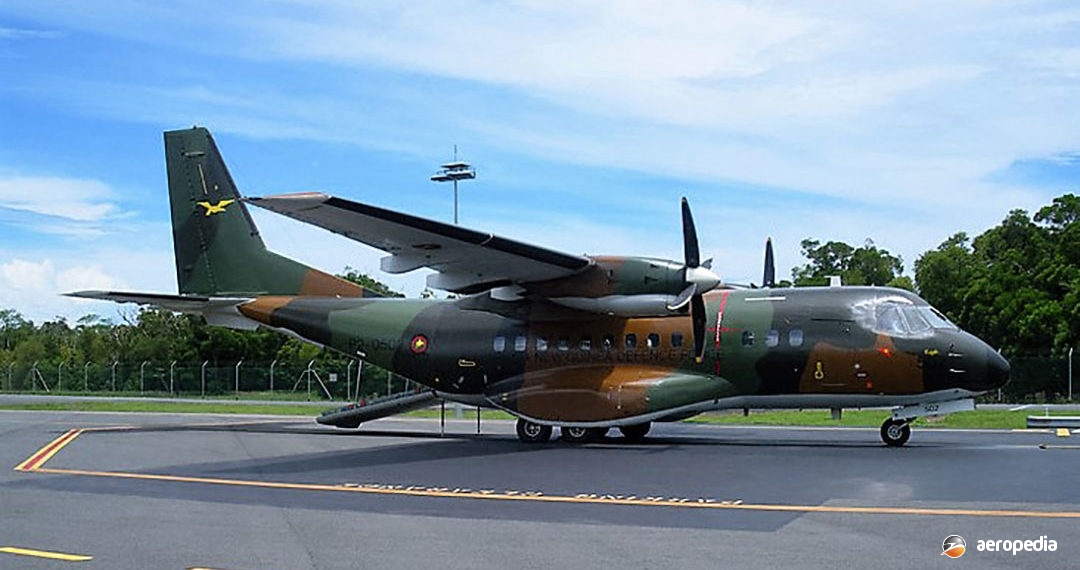Photograph:
CASA CN-235 P2-0502 (c/n C049) of the New Guinea Defence Force at Port Moresby, PNG (Nigel Apperley)
Country of origin:
Spain / Indonesia
Description:
Commercial and military transport
Power Plant:
Two 1,305 kw (1,750 shp) flat-rated General Electric CT7-9C turboprops
Specifications:
- Wingspan: 25.81 m (84 ft 8 in)
- Length: 21.35 m (70 ft)
- Height: 8.17 m (26 ft 9¾ in)
- Wing area: 59 m² (636.17 sq ft)
- Max cruising speed at 4,575 m (15,000 ft): 460 km/h (286 mph)
- Max rate of climb at sea level: 465 m/min (1,527 ft/min)
- Range with max payload at max cruising speed at 4,570 m (15,000 ft): 800 km (498 miles)
- Max range with 825 kg (1,819 lb) payload: 3,980 km (2,473 miles)
- Empty weight: 9,800 kg (27,605 lb)
- Loaded weight: 15,100 kg (33,289 lb)
- Max payload weight: 4,000 kg (8,818 lb)
History:
The CASA CN-235 was developed jointly by CASA in Spain and Industri Pesawat Terbang Nusantara (IPTN) in Indonesia as a civil and military transport, each company building a prototype, there being ceremonies held simultaneously in Spain and Indonesia, the Spanish aircraft (ECT-100) making its first flight on 11 November 1983, and the Indonesian aircraft (PT-XNC) on 30 December 1983.
Produced in three basic variants, the first was the Series 10, followed by the Series 100 with a loaded weight of 14,647 kg (32,290 lb), production of which commenced in 1988; and the Series 200 which involved structural changes to the wings conferring an increase to the range performance with a loaded weight of 15,595 kg (34,380 lb). In addition, the CN-235QC passenger/cargo variant was offered.
Following the licensed manufacture of the C-212 transport by Nurtanio in Indonesia, CASA proposed a joint development of a new airliner, the two companies forming Airtech in Madrid, Spain and agreed to a 50/50 workshare on the new project. By December 1983 the new type had received 106 firm sales and 23 options, with military operators making up 60 per cent of the market. Single source production lines were established in both countries, with larger components being transported by freight aircraft.
As a regional airliner, the CN-235 could accommodate up to 39 passengers in four-abreast seating; as a military freighter it could, in the CN-235-300 variant, carry up to 53 troops, two light vehicles of the Land Rover type, or a payload of 6,000 kg (13,228 lb), comprising two F-404 or EJ200 turbofans. As a freighter it could accept four LD-3 containers or two 2.23 m (88 in) cargo pallets.
In July 1988 the later defunct National Safety Council of Australia (NSCA) announced it was about to import two CN-235s for para-rescue drops and fire-fighting exercises, one example to be based at the organisation’s West Sale, VIC base for a week-long evaluation trial, this including mass para-rescue drops and fire-fighting exercises. However, the NSCA closed down before this could occur.
In November 1991 the Papua New Guinea Defence Force obtained two Indonesian-built CN-235M-100 examples, these occasionally visiting Australian RAAF bases. These aircraft became P2-0501 (c/n 048) and P2-0502 (c/n 049), the latter named ‘Eagle’, but only one P2-052 has been used in recent years. The other P2-051 was placed in storage without its engines and remained in this state from 2002 to 2015. However in January 2016 it was noted being restored to flying status.
Most civil aircraft built have operated in Spain and Indonesia, entering service on 1 March 1988 with Merpati operating 14 and Pelita 10. First production batch was the Series 10 with the General Electric CT7-7A engine, of which 30 were delivered before production switched to the Series 100 with the General Electric CT7-9C engine, followed by the CN-235QC passenger/cargo variant.
In January 1990 an announcement was made that the CN-235 would be licence-built in Turkey by Tusas Aerospace Industries for military use.
One variant produced was the CN-235 Persuader for maritime patrol work, this model being fitted with a rear ramp for air-dropping of rescue and life-saving equipment and having a 360 degrees search radar.
The type has also been demonstrated to a number of civil operators in this region, and to the RAAF as a Caribou replacement, the CN-235-330 Phoenix being said to be a front runner at one time, this being a variant of the CN-235-110 with a higher payload, improvements in fuel economy and changes to cockpit systems. One was demonstrated at RAAF and RAN bases in Australia, including Darwin, NT, Townsville and Amberley, QLD, Richmond and Nowra, NSW and Canberra, ACT.
Industri Pesawat Terbang Nusantara tendered in 1998 to build 12 to 18 aircraft for the Australian Defence Force, and as part of the tender consideration was given to the replacement of the General Electric engines with Pratt & Whitney Canada PW119 turboprops. Max all-up weight was 16,800 kg (37,037 lb). At the time it was expected the contract would be signed in 1999 with first deliveries expected to commence in late 2000. In the event no order was placed and the Caribou continued in service until replaced by the Alenia CJ-27 Spartan.
A further development aimed at the regional commuter market was the Indonesian variant known as the N250.
Military operators have included Abu Dhabi, Botswana, Brunei, Chile, Ecuador, French Gabon, Indonesia, South Korea, Malaysia, Morocco, Panama, Saudi Arabia, South Africa, Spain, Turkey and, as noted above, New Guinea.
In 1998 National Jet Systems announced the intention to order two IPTN CN-235 aircraft with options on a further five for coastal surveillance work through its subsidiary, Surveillance Australia. However, the contract was not received and the aircraft were not imported.

